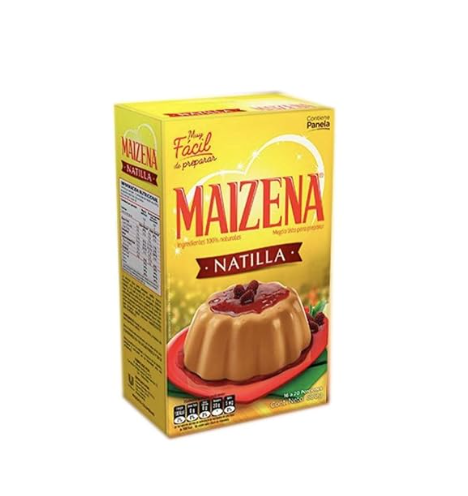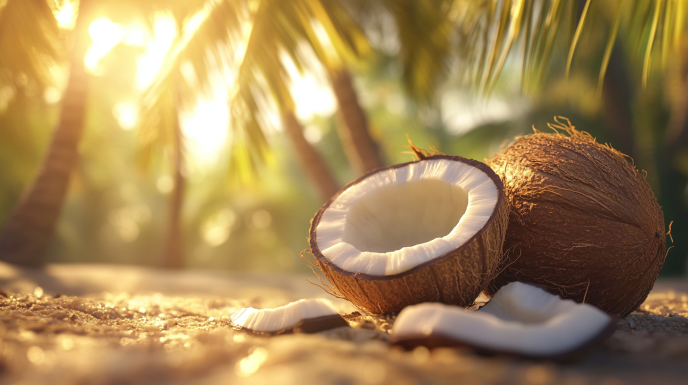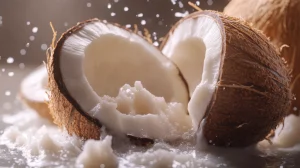
MAIZENA Natilla Colombiana Tradicional – Colombian Custard Dessert 600G Original Flavor
- In Colombia, natilla is the most popular Christmas dish and is eaten along with buñuelos and manjar blanco, and it resembles a flan or pudding. Some of the ingredients include milk, panela (blocks of brown sugar), cinnamon sticks, and flour or cornstarch. Occasionally people like to add grated coconut or raisins but these are optional ingredients.
From Grandmother’s Kitchen to Modern Tables: The Delicious Evolution of a Classic Comfort Sweet
Growing up in my grandmother’s kitchen, the gentle bubbling of a pot on the stove often signaled something magical was happening. The wooden spoon making deliberate circles, the subtle aroma of cinnamon and vanilla wafting through the air—these sensory memories are forever linked to one of my most cherished childhood treats: Maizena Natilla. This velvety, comforting dessert has transcended generations, cultural boundaries, and dietary restrictions to remain a beloved staple in countless households around the world.
Today, I’m diving deep into everything you need to know about this classic comfort dessert—from its humble origins to modern interpretations that accommodate various dietary needs and flavor preferences. Whether you’re a natilla novice or a seasoned connoisseur looking to perfect your technique, this comprehensive guide will take you through every aspect of mastering this deceptively simple yet utterly satisfying sweet.
What Exactly Is Maizena Natilla?
At its essence, Maizena Natilla is a silky, custard-like dessert made primarily with cornstarch (commonly known by the brand name “Maizena” in many Latin American countries), milk, sugar, and typically flavored with vanilla, cinnamon, or citrus zest. The result is a luxuriously smooth dessert that straddles the line between pudding and custard—thick enough to hold its shape when served but delicately yielding to the spoon.
The term “natilla” itself comes from Spanish cuisine, where it traditionally refers to a custard-like dessert. However, the Maizena version differs from traditional natilla primarily in its thickening agent—using cornstarch instead of egg yolks as the main thickener, though many recipes incorporate both for richness and texture.
What makes Maizena Natilla particularly special is its chameleon-like ability to adapt across cultures and dietary preferences while maintaining its comforting essence. From the Colombian version often topped with cinnamon to the Cuban variation sometimes incorporating cheese, this dessert has as many interpretations as there are grandmothers who make it.
The Storied Origins: A Brief History
The history of Maizena Natilla is a fascinating tale of cultural fusion. Traditional Spanish natillas traveled to Latin America during colonization, where they encountered indigenous cooking techniques and ingredients. Corn, a staple in pre-Columbian diets, eventually made its way into the recipe in the form of cornstarch.
By the early 20th century, when the Maizena brand of cornstarch gained popularity throughout Latin America, the name became synonymous with the dessert itself. What began as an adaptation born of necessity (cornstarch being more accessible and shelf-stable than eggs in many regions) evolved into a beloved dish with its own distinct identity.
The industrialization of cornstarch production made the dessert more accessible to home cooks across economic classes, cementing its status as a comforting everyday treat rather than an occasional luxury. Today, Maizena Natilla represents a beautiful culinary heritage that continues to evolve while honoring its mixed European and Latin American roots.
The Essential Ingredients: Building Blocks of Perfection
Creating the perfect Maizena Natilla begins with understanding its fundamental components. Here’s what you’ll need:
- Cornstarch (Maizena): The titular ingredient acts as the primary thickening agent, giving the dessert its characteristic texture.
- Milk: Traditionally whole milk is used for richness, though alternative milks work wonderfully for dietary variations.
- Sugar: Regular granulated sugar is standard, though some recipes call for brown sugar for deeper flavor.
- Flavorings: Vanilla extract or bean, cinnamon sticks, lemon or orange zest—these aromatics define the character of your natilla.
- Eggs: While not strictly necessary (and we’ll explore egg-free versions), egg yolks add richness and a more custard-like quality.
- Salt: Just a pinch enhances all other flavors.
The beauty of Maizena Natilla lies in its simplicity—these basic ingredients, when treated with care and attention, transform into something far greater than the sum of their parts. The precise ratios and technique make all the difference between a good natilla and an exceptional one.
Classic Maizena Natilla: The Definitive Recipe
Let’s start with a traditional recipe that captures the essence of a classic Maizena Natilla. This version incorporates egg yolks for richness but relies primarily on cornstarch for thickening:
Ingredients:
- 4 cups whole milk
- 3/4 cup granulated sugar
- 1/2 cup cornstarch (Maizena)
- 3 egg yolks (optional)
- 1 cinnamon stick
- 1 teaspoon vanilla extract
- Pinch of salt
- Ground cinnamon for garnish
Method:
- In a medium bowl, whisk together 1 cup of milk with the cornstarch until completely smooth with no lumps. Set aside.
- In a heavy-bottomed saucepan, combine the remaining 3 cups of milk with the sugar, cinnamon stick, and salt. Heat over medium heat until it just begins to simmer (do not boil).
- If using egg yolks, beat them lightly in a separate bowl.
- Slowly pour about 1 cup of the hot milk mixture into the cornstarch mixture, whisking constantly to prevent lumps. Then, add this mixture back into the saucepan, stirring continuously.
- Cook over medium-low heat, stirring constantly with a wooden spoon or silicone spatula, until the mixture thickens enough to coat the back of the spoon (about 8-10 minutes).
- If using egg yolks, temper them by slowly adding a small amount of the hot mixture while whisking constantly. Then add the tempered yolks back to the pot.
- Continue cooking for another 2-3 minutes, stirring constantly (never letting it boil vigorously).
- Remove from heat, discard the cinnamon stick, and stir in vanilla extract.
- Pour into individual serving dishes or one large bowl.
- Allow to cool slightly, then refrigerate until fully set (at least 2 hours).
- Sprinkle with ground cinnamon before serving.
The result is a silky, aromatic dessert that balances richness with delicate flavor—a perfect representation of what makes Maizena Natilla such a beloved comfort food across generations.
The Art of Lump-Free Natilla: Technique Matters
Perhaps the most common challenge when making Maizena Natilla is avoiding those dreaded lumps. Nothing ruins the luxurious experience of this dessert faster than encountering grainy bits of undissolved cornstarch. Here’s how to ensure silky smoothness every time:
- The cold slurry technique: Always mix your cornstarch with cold milk before adding it to the hot milk. This allows the starch granules to separate and distribute evenly before they begin to thicken.
- Constant, patient stirring: Once the cornstarch mixture meets the hot liquid, uninterrupted stirring becomes your most important task. Use a wooden spoon or silicone spatula to reach every corner of the pot.
- Temperature control: Maintain a medium-low heat throughout the cooking process. High heat can cause uneven thickening and scorching.
- The figure-8 method: Rather than stirring in circles, try moving your spoon in a figure-8 pattern to ensure you’re incorporating mixture from all parts of the pot.
- Straining option: If disaster strikes despite your best efforts, you can rescue a lumpy natilla by passing it through a fine-mesh sieve while still hot.
Remember that the key to perfect texture in Maizena Natilla lies in respecting the process—rushing will almost always lead to disappointing results. The few extra minutes of attentive stirring pay tremendous dividends in the final texture.
Beyond Tradition: Egg-Free Maizena Natilla
While traditional recipes often include egg yolks for added richness, many modern interpretations omit them entirely. This adaptation makes the dessert not only simpler to prepare but also suitable for those with egg allergies or following vegan diets when combined with plant-based milk.
The egg-free version relies entirely on cornstarch for thickening, resulting in a slightly different but equally delicious texture. The absence of eggs creates a cleaner, more direct flavor profile where the aromatics can really shine. Here’s a simplified egg-free recipe:
Ingredients:
- 4 cups milk (dairy or plant-based)
- 3/4 cup sugar
- 1/3 cup cornstarch (slightly more than the egg version)
- 1 cinnamon stick
- 1 tablespoon vanilla extract
- Pinch of salt
Follow the same cooking method as the classic recipe, omitting the egg steps. You may need to cook the mixture slightly longer to achieve the desired thickness, as you won’t have the additional thickening power of the egg proteins.
Nutritional Profile: Understanding the Calories
For the calorie-conscious, understanding the nutritional profile of Maizena Natilla can help you enjoy this treat mindfully. A typical serving (about 1/2 cup) of traditional Maizena Natilla made with whole milk and eggs contains approximately:
- Calories: 180-220 kcal
- Carbohydrates: 30-35g
- Protein: 4-6g
- Fat: 6-8g
The exact values vary based on specific ingredients and proportions. Using lower-fat milk can reduce the calorie count significantly, while plant-based variations might have different nutritional profiles depending on the type of milk used.
What makes Maizena Natilla nutritionally interesting is that despite being a dessert, it offers some notable benefits: it provides calcium from milk, some protein, and when made with whole ingredients rather than artificial flavors or stabilizers, it represents a relatively clean indulgence compared to many commercial desserts.
Dietary Considerations: Is Maizena Natilla Gluten-Free?
Good news for those with celiac disease or gluten sensitivity: pure cornstarch is naturally gluten-free, making Maizena Natilla a suitable dessert option. However, always check your specific brand of cornstarch for potential cross-contamination warnings if you have severe gluten sensitivities.
It’s worth noting that while the dessert is gluten-free, it is traditionally made with dairy and sometimes eggs, so those with other food sensitivities may need to consider adaptations. Fortunately, as we’ll explore below, Maizena Natilla lends itself beautifully to various dietary modifications.
Chocolate Maizena Natilla: A Decadent Variation
For chocolate lovers, transforming the classic vanilla-cinnamon natilla into a chocolate version is surprisingly simple and utterly satisfying. The rich cocoa flavors blend perfectly with the creamy texture of the dessert.
Ingredients:
- 4 cups whole milk
- 3/4 cup sugar
- 1/2 cup cornstarch
- 1/3 cup unsweetened cocoa powder
- 3 egg yolks (optional)
- 1 teaspoon vanilla extract
- Pinch of salt
- Chocolate shavings for garnish
Method:
- Whisk the cornstarch with 1 cup of cold milk as in the classic recipe.
- In a separate bowl, mix the cocoa powder with a small amount of the cornstarch-milk mixture to form a smooth paste, then incorporate it back into the cornstarch mixture.
- Follow the same cooking method as the classic recipe, adjusting sweetness as needed since cocoa adds bitterness.
- Garnish with chocolate shavings instead of cinnamon.
The chocolate version offers a more intense flavor experience while maintaining the characteristic silky texture that makes Maizena Natilla so beloved.
Plant-Based Possibilities: Alternative Milk Natilla
The versatility of Maizena Natilla extends beautifully to non-dairy versions. Almost any plant-based milk works well, though each brings its own unique character to the final dessert:
- Almond milk creates a lighter natilla with subtle nutty notes
- Coconut milk produces a richly tropical version with distinctive flavor
- Oat milk offers a creamy result closest to the traditional dairy version
- Soy milk provides the highest protein content and a neutral flavor base
When making plant-based versions, you may need to adjust the cornstarch slightly (usually increasing by 1-2 tablespoons) as plant milks sometimes thicken differently than dairy milk. Additionally, you might want to increase vanilla or other flavorings to compensate for the less creamy base.
For a fully vegan Maizena Natilla, simply use plant milk and omit the eggs, increasing cornstarch as noted in the egg-free recipe above.
Global Variations: Regional Twists on a Classic
As Maizena Natilla traveled across cultures, it picked up delightful regional variations that showcase local ingredients and preferences:
- Colombian natilla often includes grated fresh cheese and sometimes coconut
- Cuban versions might incorporate a touch of lemon or lime zest
- Puerto Rican interpretations frequently add coconut milk or cream
- Mexican variations often feature piloncillo (unrefined cane sugar) instead of granulated sugar
- Southern European adaptations might include orange blossom water or honey
These regional differences highlight how this simple dessert adapts to local taste preferences while maintaining its essential comforting character. Exploring these variations offers a delicious way to experience different cultural approaches to the same beloved dessert.
Storage Secrets: Keeping Natilla Fresh
Properly stored, Maizena Natilla can maintain its delicious quality for several days. Here are the best practices for storage:
- Cool completely before refrigerating to prevent condensation.
- Cover with plastic wrap placed directly on the surface of the natilla to prevent a skin from forming.
- Refrigerate promptly and consume within 3-4 days for best quality.
- Avoid freezing as the texture significantly deteriorates when thawed.
If you notice liquid separation after storage (syneresis), simply stir gently before serving. The texture may not be quite as perfect as freshly made natilla, but the flavor remains delicious.
Temperature Matters: Cold vs. Warm Natilla
While traditional serving suggestions typically call for chilled Maizena Natilla, temperature preferences vary widely across regions and families. In some traditions, natilla is enjoyed still slightly warm, with its comforting, just-made creaminess.
Cold natilla develops a firmer, more set texture and often has more pronounced flavors as the ingredients have time to meld. Warm natilla offers a cozier, more comforting experience—particularly welcome in cooler months.
There’s no right or wrong here—it’s purely a matter of personal preference. Some natilla enthusiasts even enjoy trying both ways with the same batch to experience the textural and flavor differences.
Natilla vs. Pudding: Understanding the Distinction
Confusion often arises between Maizena Natilla and conventional pudding. While similar, there are notable differences:
- Thickness: Natilla typically has a firmer, more set consistency than many puddings.
- Ingredients: Traditional puddings often rely more heavily on eggs, while natilla emphasizes cornstarch.
- Flavor profile: Natilla frequently features cinnamon and sometimes citrus notes, which aren’t as common in standard puddings.
- Cultural context: Natilla has specific cultural significance in Spanish and Latin American cuisines.
Think of natilla as pudding’s sophisticated cousin—they’re related but distinct in both preparation and character. The cornstarch-forward approach gives natilla its characteristic silky-yet-firm texture that sets it apart from other creamy desserts.
Time Investment: From Ingredients to Indulgence
One of the many appeals of Maizena Natilla is its relatively quick preparation time compared to many other desserts. From start to finish, you can expect:
- Preparation: 5-10 minutes
- Cooking: 15-20 minutes
- Cooling/Setting: At least 2 hours (preferably 4+)
The active cooking time is minimal, making this an excellent option for busy home cooks. The majority of the time investment is passive cooling and setting, during which you’re free to attend to other tasks.
Beyond Dessert: Creative Uses for Maizena Natilla
While traditionally enjoyed as a standalone dessert, Maizena Natilla’s versatility extends to numerous creative applications:
- Layer cake filling: Use slightly thicker natilla between cake layers
- Fruit parfaits: Alternate with fresh fruits for an elegant presentation
- Pastry filling: Pipe into éclairs or profiteroles
- Toast topping: Spread on crusty bread for an indulgent breakfast
- Ice cream base: Use as a starting point for homemade ice cream
The neutral yet flavorful profile of classic natilla makes it an excellent canvas for creative culinary experiments. Its stability when chilled also makes it practical for various applications beyond the simple dessert cup.
Spice It Up: Flavor Enhancements and Additions
While the classic cinnamon-vanilla profile of Maizena Natilla is timeless, countless variations can be achieved through thoughtful spice and flavor additions:
- Cardamom: A few crushed pods add exotic fragrance
- Star anise: Imparts a subtle licorice note
- Nutmeg: A small grating adds warmth and complexity
- Orange or lemon zest: Brightens the flavor profile
- Coffee: A tablespoon of instant espresso creates a tiramisu-like variation
- Rosewater: Just a few drops offer delicate floral notes
The key to successful flavoring is subtlety—these additions should complement rather than overwhelm the fundamental creamy character of the dessert. When experimenting, start with smaller amounts and adjust to taste.
Kid-Friendly Natilla: A Family Favorite
Maizena Natilla ranks among the most child-friendly desserts thanks to its mild flavor, appealing texture, and simple ingredient list. For younger palates, consider these adaptations:
- Sweeter versions with a touch more sugar or honey
- Fun presentations in colorful bowls or with sprinkles
- Fruit additions like mashed banana or strawberry puree
- Cookie crumble toppings for textural contrast
Many parents appreciate that natilla provides calcium and protein along with its sweetness, making it a more nutritious treat option compared to many commercial desserts marketed to children.
Dairy-Free Creaminess: The Ultimate Vegan Natilla
Creating a truly creamy dairy-free Maizena Natilla requires thoughtful ingredient selection. Here’s how to achieve maximum creaminess without any animal products:
- Use full-fat coconut milk as the base for richness
- Add a tablespoon of coconut oil for additional mouthfeel
- Increase vanilla extract to enhance flavor depth
- Consider adding 1-2 tablespoons of nut butter for richness
- Use a touch more cornstarch for proper setting
This approach yields a vegan natilla so creamy and satisfying that even dairy enthusiasts might not notice the difference. The combination of fat, flavor, and proper thickening creates the luxurious texture that defines a successful natilla.
The Emotional Connection: Why Natilla Matters
Beyond its delicious taste and simple preparation, Maizena Natilla holds a special place in many food cultures because of its emotional resonance. For countless people, this dessert evokes powerful memories of childhood, family gatherings, and cultural heritage.
The act of stirring natilla on the stove—a process that cannot be rushed—represents a form of culinary meditation passed down through generations. In our fast-paced modern world, this deliberate, attentive cooking process offers a moment of connection with tradition and mindfulness.
Perhaps this explains why, despite endless innovation in the dessert world, this humble cornstarch pudding continues to be made in homes around the world. It’s not just about the sweet, creamy result—it’s about the comforting process, the familiar aroma, and the knowledge that you’re participating in a culinary tradition that has nourished families for generations.
Conclusion: The Timeless Appeal of Simplicity
In a culinary landscape often dominated by complex techniques and exotic ingredients, Maizena Natilla stands as a testament to the enduring power of simplicity. With just a handful of pantry staples and mindful technique, this dessert creates a moment of pure pleasure that transcends age, culture, and dietary preference.
Whether you’re recreating your grandmother’s exact recipe or experimenting with modern adaptations, the essence of Maizena Natilla remains the same—a celebration of how transformative the simplest ingredients can be when treated with care and attention.
So the next time you find yourself craving a dessert that comforts both body and soul, reach for the cornstarch, heat some milk, and embark on the meditative process of creating this timeless treat. Your reward will be not just a delicious dessert, but a connection to a rich culinary tradition that continues to bring joy to tables around the world.






